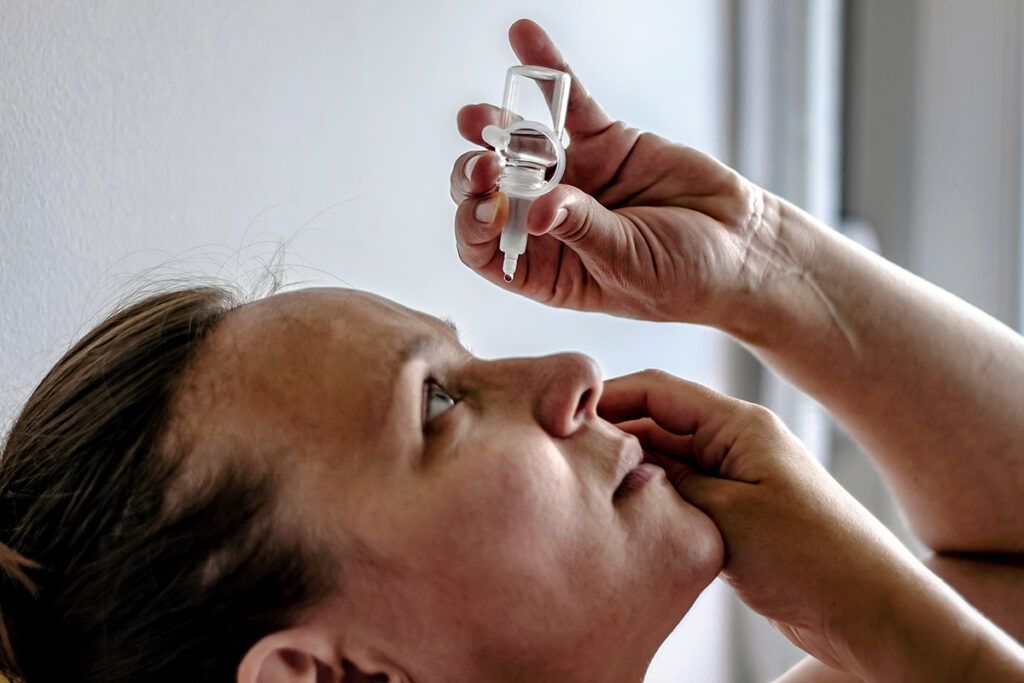Conjunctivitis, commonly known as pink eye, is an inflammation of the conjunctiva. The conjunctiva is a thin tissue that lines the inner surface of the eyelids. Conjunctivitis can lead to eye symptoms such as redness, itching, tearing, and eye discharge.
There are several types of conjunctivitis, such as viral, allergic, bacterial, and chemical. Each type has different causes and treatment options. This is why it’s important to speak with a healthcare professional to ensure you get a correct diagnosis and effective treatment plan.
Viral conjunctivitis

Viral conjunctivitis, also known as pink eye, is an inflammation of the conjunctiva caused by a viral infection, most commonly by the adenovirus. It’s highly contagious and can spread through direct contact or touching contaminated surfaces.
Symptoms
Symptoms of viral conjunctivitis can include:
- redness in the white of the eye and inner eyelid
- watery discharge
- itchiness or irritation
- grittiness or foreign body sensation
- swollen eyelids
- light sensitivity
- mild pain or discomfort
- crustiness around the eyelids, particularly in the morning
Viral conjunctivitis symptoms may also accompany other symptoms of a viral infection, such as a sore throat or runny nose.
Treatment options
Treatment options for viral conjunctivitis aim to ease symptoms and promote comfort. According to the Centers for Disease Control and Prevention (CDC), the infection typically resolves on its own within 1–2 weeks. Treatment options may include:
- Artificial tears or lubricating eye drops: These over-the-counter (OTC) eye drops help reduce dryness and soothe discomfort or irritation. Brand names of commonly used lubricating eye drops include Refresh and Systane.
- Cold compresses: You can apply a cold compress or clean washcloth soaked in cold water to the affected eye(s). This will help lower inflammation and ease symptoms.
- Hygiene and prevention: A good hygiene practice is important to help prevent the spread of viral conjunctivitis. This includes:
- avoiding touching or rubbing the eyes
- washing hands frequently with soap and warm water
- avoiding sharing towels or pillows
- disinfecting frequently touched surfaces
Viral conjunctivitis does not typically require prescription medications. According to the CDC, antibiotics are not effective against viral infections, and doctors do not routinely prescribe them for viral conjunctivitis. But a healthcare professional may prescribe antiviral medications in severe cases.
Bacterial conjunctivitis
Bacterial conjunctivitis is an inflammation of the conjunctiva caused by a bacterial infection. The most common bacteria responsible for this condition include Staphylococcus aureus in adults and Haemophilus influenzae in children.
Bacterial conjunctivitis is highly contagious and can spread through direct contact or by touching contaminated objects.
Symptoms
Eye symptoms of bacterial conjunctivitis may include the following:
- redness
- a thick yellow or greenish discharge
- itchiness of the affected eye(s)
- eyelid swelling
- grittiness or foreign body sensation
- too much tearing
Treatment options
A healthcare professional may prescribe antibiotic eye drops or ointments to manage bacterial conjunctivitis effectively. Antibiotics can help treat the bacterial infection, lower the spread of infection, and prevent complications such as a corneal ulcer (an open sore in the eye).
Mild bacterial conjunctivitis may get better without antibiotic treatment. It often improves in 2–5 days but can take 2 weeks to heal completely.
Commonly prescribed antibiotics for bacterial conjunctivitis include polymyxin b-trimethoprim (Polytrim) and moxifloxacin (Vigamox).
It’s important to follow the prescribed dosage and length of treatment. This helps treat the infection and prevent it from occurring again (recurrence).
In addition to antibiotic eye drops or ointments, practicing good hygiene is important. This is to help prevent the spread and recurrence of bacterial conjunctivitis. A healthcare professional may recommend:
- washing hands frequently
- avoiding touching or rubbing the eyes
- avoiding sharing towels, pillows, or other personal items
If you need help covering the cost of medications, the free Optum Perks Discount Card could help you save up to 80% on prescription drugs. Follow the links on drug names for savings on that medication, or search for a specific drug here.
